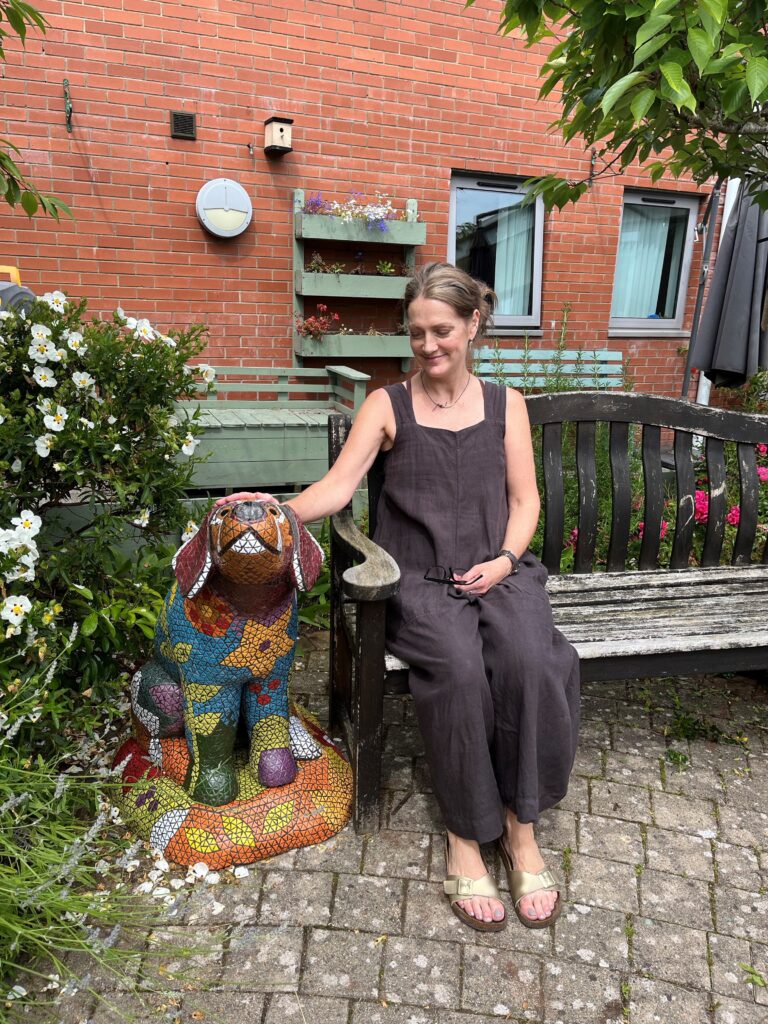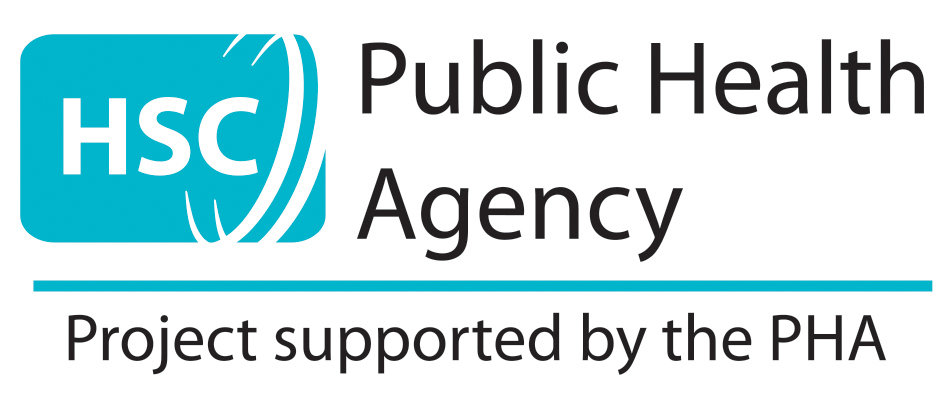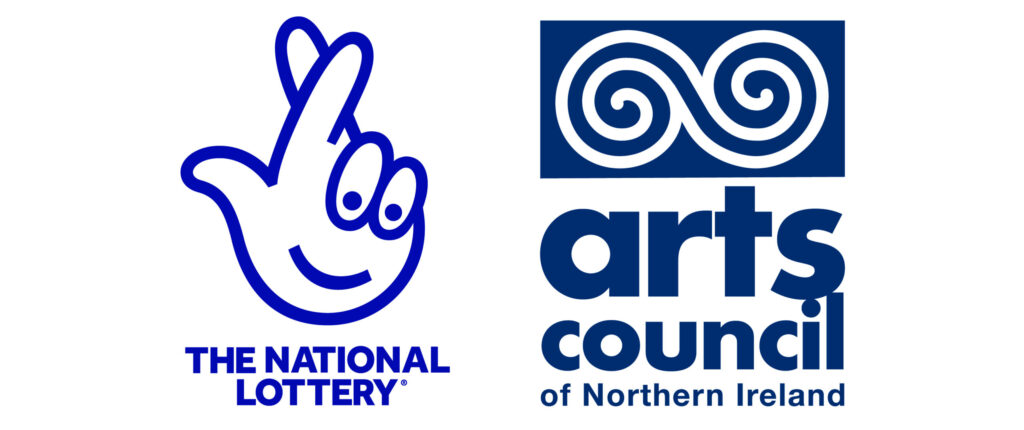A sculpture project helping people process grief, memory and connection
Daycare worker Rachel McKinstry and service user Ron reflect on the long journey of the ‘Good Grief’ project, a mosaic sculpture facilitated by Arts Care artist Helen Shields. Developed over several years, the project helped reconnect the Enler Day Centre community after the pandemic and provided a powerful outlet for expressing love, loss and memory.
A Project Rooted in Loss and Love
The Good Grief project at the Enler Day Centre has been an evolving work over several years, with a therapeutic group first established in the Centre in 2019 to look at the subject of bereavement and loss.
A number of years have passed in the interim, with the project moving through a number of phases, staff changes and a global pandemic – all of which impacted progress. However, as we are all aware, there is no time limit on grief, and it is fitting therefore that the project has continued on – thoughtfully, quietly moving towards its conclusion in 2024, under the careful hand of Arts Care artist Helen Shields.
The aim of the project, from its inception, was to design and produce a permanent art installation in the sensory garden within the Centre. The vision was that this installation would enhance the therapeutic environment of the garden, allowing service users to feel safe and supported in times of stress or crisis. The mission was to create a sculptural dog, which to the focus group suggested comfort, companionship and support, and which would add colour and interest in the courtyard garden throughout the year.
From Framework to Form
Production began in 2020, with a strong metal skeleton forged by a local artist. Helen began adding layers of wire mess to create the shape of a dog, followed by layers of cement, until a strong and stable design emerged.
Piecing Together the Mosaic
In 2021 the dog was delivered to the Enler Centre, which had only recently reopened to a small group of service users, due to Covid restrictions. At this point, a group of service users were able to begin adding mosaic tiles to the dog structure at weekly workshops. Slowly and steadily a colourful mosaic sculpture appeared, led by Helen, who supported the many people who took part in creating this project.
The commitment and focus of a small group of participants saw the piece finally completed in 2024, when the sculpture was finally installed in the sensory courtyard garden.
Ron’s Story: Healing Through Making
One participant, a gentleman called Ron, was particularly taken by the piece, and chose to put in many hours working alongside Helen on the sculpture. I was delighted to meet Ron on a recent visit to the centre and asked him about his experience with the project. He told me, “I’ve always had useful hands, so that was why I offered to help. My father was the same, and my mother. I learned that from them – the ingenuity and the interest in doing something. There is always something that catches your eye, and you just think ‘I want to learn how to do that!’
And that was what happened when Ron met Helen at the centre. He had begun attending the centre after the loss of his wife, and he quickly became very invested in the creation of their dog.
“My mother bred dogs, so I was around dogs all my life. My childhood dog, Rinky Monaghan, was more than just a companion. I sent hours out walking with him, and my brother. He could do anything, and really looked after us two boys. He always stood with us. So, I really liked the dog we were making – there was just a lovely feeling about it. The size, everything, it was just right.”
Unlocking Conversations Through Creativity
Helen recalls that there was something about the sculpture being a dog that seemed to unlock lots of feelings and conversations amongst the staff and service users at the centre. “It was a great talking point with service users, staff, and visitors, opening of course with conversations about much loved pets.
People watched the project evolve over time, and many wandered over to chat, or to help. Conversations flowed – about possible names, and cherished memories of pets, and people, now gone. He did what all pets do really and became a much-loved part of the centre family, even before he was finally completed.”
A Deep Emotional Connection
Ron feels a strong bond with the dog now – as we walk along the corridor past the garden where he is situated, Ron’s face lights up at the first glimpse of him. He says: “I could just lie down there beside him. I love him!
“I have to be occupied. I loved working on this and would love to do this kind of thing again. It’s surprising what you can do when you have the mindset to improve and be willing to learn. But you can’t do something like this alone – it takes there to be an invitation, an opportunity. And I like things that bring people together. People agreed to work together for this, and that is the most important thing in life, to have friends.
The Dog as a Centrepiece for Community and Reflection
Daycare worker Rachel McKinstry tells me: “We have a Love and Loss group, and the dog has been a part of that – the process of creating him came from discussions on how to encapsulate some of our previous discussions in an art piece. People really connect with him and are very attracted to him.
It is lovely having his colour in the garden and I am looking forward to warmer weather when people can get out and sit with him more. He is a big part of the centre now. And there is a lot of discussion about what his name should be. He definitely needs a name, but it is lovely hearing all the names of people’s pets too!”
Rebuilding Community After the Pandemic
Rachel explains that the whole project was been a useful vehicle for bringing together staff and service users, and their families, something which was particularly challenging but incredibly important during the end of pandemic restrictions.
“Art should be, and is, a huge element of activity in a day centre, and that objective was lost during the restrictions, so this project really helped with rebuilding that method of connection. Especially as it lasted such a long time – so many people ere able to take part, and watch it progress.
“There were people who participated who are no longer with us, so it is lovely having their work still here too. And for some people, like Ron, it was a long-term commitment. He worked hard on the dog, and that helped him through a difficult time.”
Ron agrees: “I came to the centre after my wife passed, to learn to live again. Working on this was great. The dog needed me, and I needed the dog.”
Case Study by Ali Fell on behalf of Arts Care






